Business Law: Exploring the English Legal System and Solutions
VerifiedAdded on 2024/04/25
|17
|4208
|438
Report
AI Summary
This report provides a comprehensive analysis of the English Legal System, covering various aspects such as its structure, sources of law, and the role of government in law-making. It explores the differences between common and statutory law and their application in justice courts. Furthermore, it examines employers’ legal obligations related to occupational health and safety, workers' compensation, harassment, and equal opportunities, detailing the potential impacts of employment and contract law on businesses. The report suggests appropriate legal solutions for business problems, justifying them with relevant statutes and case law. It also assesses the positive and negative impacts of these legal solutions and critically reviews alternative legal advice. Finally, the report explains the concept and benefits of using Alternative Dispute Resolution processes and recommends alternative legal solutions to business problems, comparing and contrasting their effectiveness while critically evaluating their use against alternative advice. The document is available on Desklib, a platform offering study tools and resources for students.
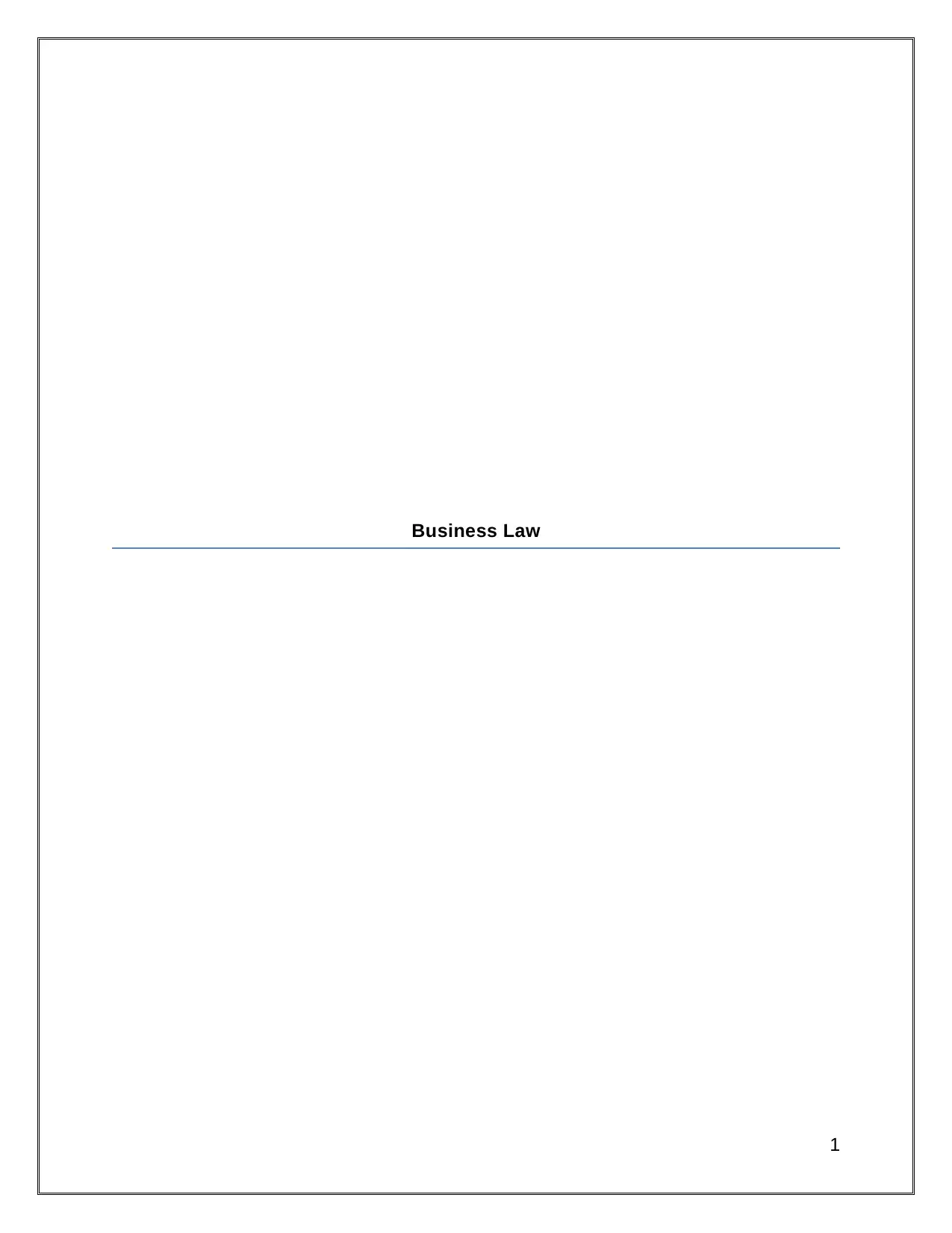
Business Law
1
1
Paraphrase This Document
Need a fresh take? Get an instant paraphrase of this document with our AI Paraphraser

Contents
Introduction.................................................................................................................................................. 3
LO1.............................................................................................................................................................. 4
a) Explain the structure of the English legal system and discuss the different sources of laws that
organisations must comply with. (P1)...................................................................................................... 4
b) Explain the role of government in law-making and how statutory and common law is applied in
the justice courts. (P2)............................................................................................................................. 4
You will evaluate the effectiveness of the legal system in terms of recent reforms and developments
[M1]......................................................................................................................................................... 6
Provide a coherent and critical evaluation of the English legal system and law, with evidence drawn
from a range of different relevant examples to support your judgment. [D1]...........................................7
LO2.............................................................................................................................................................. 8
a) Briefly explain employers’ legal obligations in relation to;............................................................8
b) Explain how the relevant employment and contract law will have a potential impact upon the
business in this scenario......................................................................................................................... 9
You will differentiate and analyse the potential impacts of regulations, legislation and standards with
regards the above scenario. [M2].......................................................................................................... 10
LO3............................................................................................................................................................ 11
P4 - Suggest appropriate legal solutions for each of the above business problems..............................11
P5 - Provide justifications for your solutions by either referring to a relevant statute or using an
appropriate case.................................................................................................................................... 11
You will assess the positive and negative impacts of legal solutions to the business problems. [M3]...12
You will critically review and evaluate the use of appropriate legal solutions in comparison with
alternative legal advice. [D2]................................................................................................................. 12
LO4............................................................................................................................................................ 13
a) Explain the concept and benefits of using Alternative Dispute Resolution process...................13
b) Recommend alternative legal solutions to the following business problem. You can consider
another country’s legal system or a different legal framework...............................................................13
You will compare and contrast the effectiveness of two different recommendations [M4].....................14
You will critically review and evaluate the use of appropriate legal solutions in comparison with
alternative legal advice [D2].................................................................................................................. 14
Conclusion................................................................................................................................................. 15
References................................................................................................................................................ 16
2
Introduction.................................................................................................................................................. 3
LO1.............................................................................................................................................................. 4
a) Explain the structure of the English legal system and discuss the different sources of laws that
organisations must comply with. (P1)...................................................................................................... 4
b) Explain the role of government in law-making and how statutory and common law is applied in
the justice courts. (P2)............................................................................................................................. 4
You will evaluate the effectiveness of the legal system in terms of recent reforms and developments
[M1]......................................................................................................................................................... 6
Provide a coherent and critical evaluation of the English legal system and law, with evidence drawn
from a range of different relevant examples to support your judgment. [D1]...........................................7
LO2.............................................................................................................................................................. 8
a) Briefly explain employers’ legal obligations in relation to;............................................................8
b) Explain how the relevant employment and contract law will have a potential impact upon the
business in this scenario......................................................................................................................... 9
You will differentiate and analyse the potential impacts of regulations, legislation and standards with
regards the above scenario. [M2].......................................................................................................... 10
LO3............................................................................................................................................................ 11
P4 - Suggest appropriate legal solutions for each of the above business problems..............................11
P5 - Provide justifications for your solutions by either referring to a relevant statute or using an
appropriate case.................................................................................................................................... 11
You will assess the positive and negative impacts of legal solutions to the business problems. [M3]...12
You will critically review and evaluate the use of appropriate legal solutions in comparison with
alternative legal advice. [D2]................................................................................................................. 12
LO4............................................................................................................................................................ 13
a) Explain the concept and benefits of using Alternative Dispute Resolution process...................13
b) Recommend alternative legal solutions to the following business problem. You can consider
another country’s legal system or a different legal framework...............................................................13
You will compare and contrast the effectiveness of two different recommendations [M4].....................14
You will critically review and evaluate the use of appropriate legal solutions in comparison with
alternative legal advice [D2].................................................................................................................. 14
Conclusion................................................................................................................................................. 15
References................................................................................................................................................ 16
2

Introduction
The present report focuses on providing coherent information regarding English Legal
System. The purpose of law, evolution of law and sources of law that frames the basis
of formation of law under English legal system has been discussed providing a brief
discussion about role of government in law making. The impact of employment laws in
context of business have been explained by laying context on legislation that is required
to be complied by business organisations. The terms of contract law bind parties under
it, however, in order to avoid any issue that can provide for speedy solution to litigants is
also discussed. The alternative dispute resolution mechanism is a boon in context of
resolving disputes and decreasing burden from courts and providing appropriate and
secured solution to parties under dispute.
3
The present report focuses on providing coherent information regarding English Legal
System. The purpose of law, evolution of law and sources of law that frames the basis
of formation of law under English legal system has been discussed providing a brief
discussion about role of government in law making. The impact of employment laws in
context of business have been explained by laying context on legislation that is required
to be complied by business organisations. The terms of contract law bind parties under
it, however, in order to avoid any issue that can provide for speedy solution to litigants is
also discussed. The alternative dispute resolution mechanism is a boon in context of
resolving disputes and decreasing burden from courts and providing appropriate and
secured solution to parties under dispute.
3
⊘ This is a preview!⊘
Do you want full access?
Subscribe today to unlock all pages.

Trusted by 1+ million students worldwide
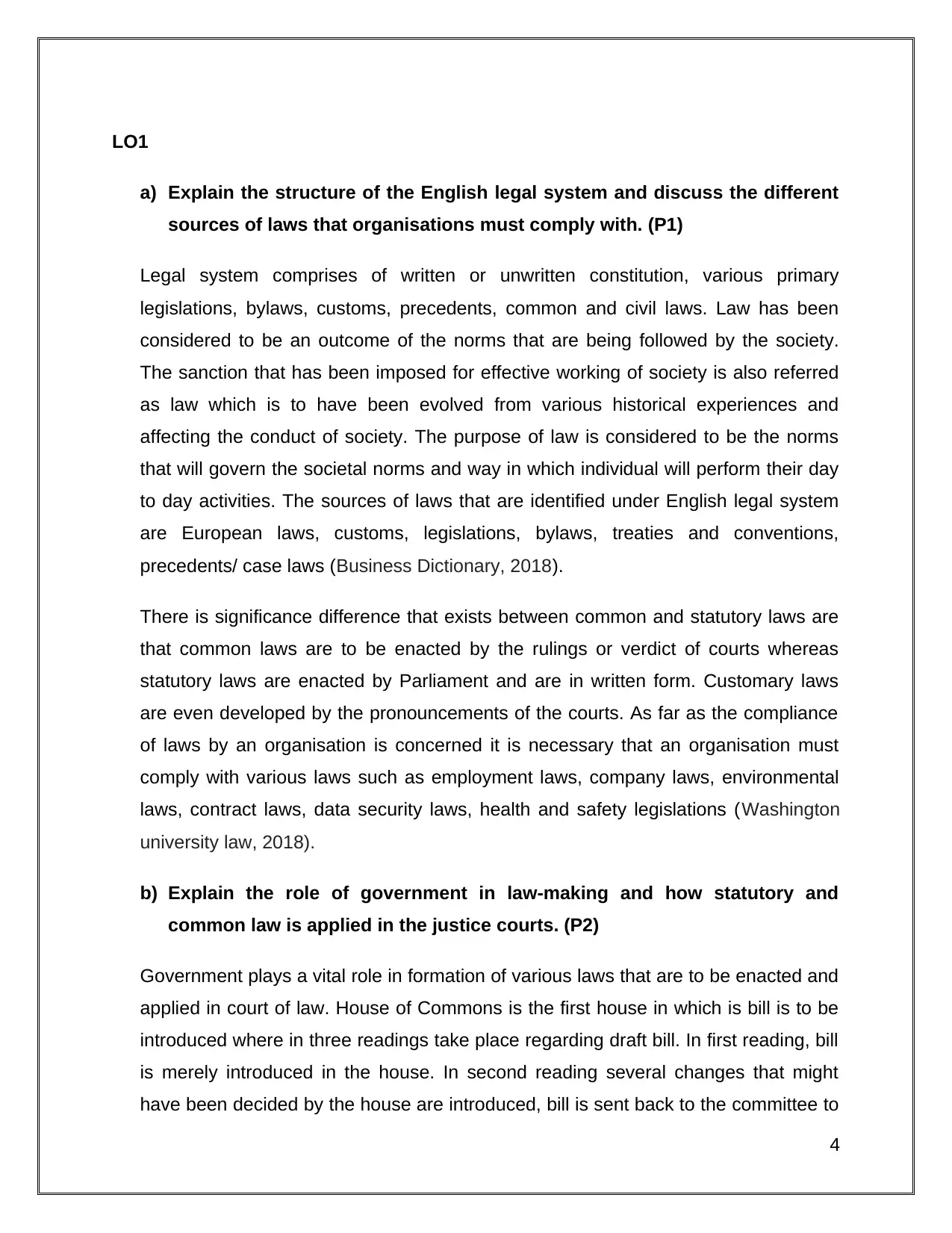
LO1
a) Explain the structure of the English legal system and discuss the different
sources of laws that organisations must comply with. (P1)
Legal system comprises of written or unwritten constitution, various primary
legislations, bylaws, customs, precedents, common and civil laws. Law has been
considered to be an outcome of the norms that are being followed by the society.
The sanction that has been imposed for effective working of society is also referred
as law which is to have been evolved from various historical experiences and
affecting the conduct of society. The purpose of law is considered to be the norms
that will govern the societal norms and way in which individual will perform their day
to day activities. The sources of laws that are identified under English legal system
are European laws, customs, legislations, bylaws, treaties and conventions,
precedents/ case laws (Business Dictionary, 2018).
There is significance difference that exists between common and statutory laws are
that common laws are to be enacted by the rulings or verdict of courts whereas
statutory laws are enacted by Parliament and are in written form. Customary laws
are even developed by the pronouncements of the courts. As far as the compliance
of laws by an organisation is concerned it is necessary that an organisation must
comply with various laws such as employment laws, company laws, environmental
laws, contract laws, data security laws, health and safety legislations (Washington
university law, 2018).
b) Explain the role of government in law-making and how statutory and
common law is applied in the justice courts. (P2)
Government plays a vital role in formation of various laws that are to be enacted and
applied in court of law. House of Commons is the first house in which is bill is to be
introduced where in three readings take place regarding draft bill. In first reading, bill
is merely introduced in the house. In second reading several changes that might
have been decided by the house are introduced, bill is sent back to the committee to
4
a) Explain the structure of the English legal system and discuss the different
sources of laws that organisations must comply with. (P1)
Legal system comprises of written or unwritten constitution, various primary
legislations, bylaws, customs, precedents, common and civil laws. Law has been
considered to be an outcome of the norms that are being followed by the society.
The sanction that has been imposed for effective working of society is also referred
as law which is to have been evolved from various historical experiences and
affecting the conduct of society. The purpose of law is considered to be the norms
that will govern the societal norms and way in which individual will perform their day
to day activities. The sources of laws that are identified under English legal system
are European laws, customs, legislations, bylaws, treaties and conventions,
precedents/ case laws (Business Dictionary, 2018).
There is significance difference that exists between common and statutory laws are
that common laws are to be enacted by the rulings or verdict of courts whereas
statutory laws are enacted by Parliament and are in written form. Customary laws
are even developed by the pronouncements of the courts. As far as the compliance
of laws by an organisation is concerned it is necessary that an organisation must
comply with various laws such as employment laws, company laws, environmental
laws, contract laws, data security laws, health and safety legislations (Washington
university law, 2018).
b) Explain the role of government in law-making and how statutory and
common law is applied in the justice courts. (P2)
Government plays a vital role in formation of various laws that are to be enacted and
applied in court of law. House of Commons is the first house in which is bill is to be
introduced where in three readings take place regarding draft bill. In first reading, bill
is merely introduced in the house. In second reading several changes that might
have been decided by the house are introduced, bill is sent back to the committee to
4
Paraphrase This Document
Need a fresh take? Get an instant paraphrase of this document with our AI Paraphraser

reframing. Third reading provides for final reading of bill which after being approved
by the house reaches the stage of reporting. After getting passed from House of
Commons bill is then introduced in House of Lords where similar reading takes place
as in House of Commons. Once a bill is approved by both houses is ready being
notified in official gazette after getting assent from Royal head. On getting affixed by
royal seal bill then becomes a notified law that has been considered to become a
part of Acts of Parliament (www. Parliament .uk., 2018).
Figure 2: stages of passing bill
Source: www.parliament.uk, 2018
The statutory and common laws are applied in court of law in different manners. The
statutory laws are written laws that can be applied in court of law once any question
of law concerning particular statue comes before court. As far as the point of
5
by the house reaches the stage of reporting. After getting passed from House of
Commons bill is then introduced in House of Lords where similar reading takes place
as in House of Commons. Once a bill is approved by both houses is ready being
notified in official gazette after getting assent from Royal head. On getting affixed by
royal seal bill then becomes a notified law that has been considered to become a
part of Acts of Parliament (www. Parliament .uk., 2018).
Figure 2: stages of passing bill
Source: www.parliament.uk, 2018
The statutory and common laws are applied in court of law in different manners. The
statutory laws are written laws that can be applied in court of law once any question
of law concerning particular statue comes before court. As far as the point of
5
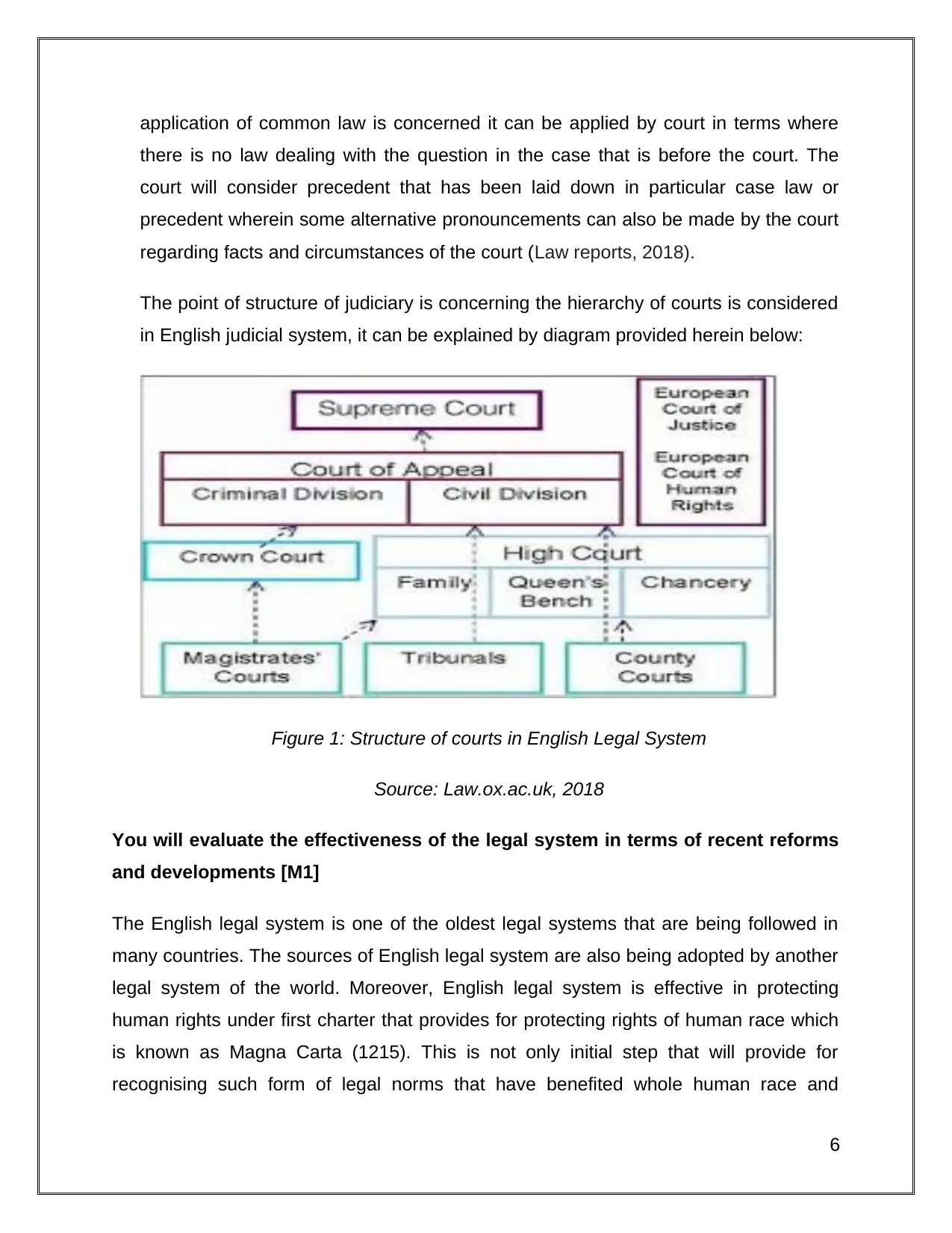
application of common law is concerned it can be applied by court in terms where
there is no law dealing with the question in the case that is before the court. The
court will consider precedent that has been laid down in particular case law or
precedent wherein some alternative pronouncements can also be made by the court
regarding facts and circumstances of the court (Law reports, 2018).
The point of structure of judiciary is concerning the hierarchy of courts is considered
in English judicial system, it can be explained by diagram provided herein below:
Figure 1: Structure of courts in English Legal System
Source: Law.ox.ac.uk, 2018
You will evaluate the effectiveness of the legal system in terms of recent reforms
and developments [M1]
The English legal system is one of the oldest legal systems that are being followed in
many countries. The sources of English legal system are also being adopted by another
legal system of the world. Moreover, English legal system is effective in protecting
human rights under first charter that provides for protecting rights of human race which
is known as Magna Carta (1215). This is not only initial step that will provide for
recognising such form of legal norms that have benefited whole human race and
6
there is no law dealing with the question in the case that is before the court. The
court will consider precedent that has been laid down in particular case law or
precedent wherein some alternative pronouncements can also be made by the court
regarding facts and circumstances of the court (Law reports, 2018).
The point of structure of judiciary is concerning the hierarchy of courts is considered
in English judicial system, it can be explained by diagram provided herein below:
Figure 1: Structure of courts in English Legal System
Source: Law.ox.ac.uk, 2018
You will evaluate the effectiveness of the legal system in terms of recent reforms
and developments [M1]
The English legal system is one of the oldest legal systems that are being followed in
many countries. The sources of English legal system are also being adopted by another
legal system of the world. Moreover, English legal system is effective in protecting
human rights under first charter that provides for protecting rights of human race which
is known as Magna Carta (1215). This is not only initial step that will provide for
recognising such form of legal norms that have benefited whole human race and
6
⊘ This is a preview!⊘
Do you want full access?
Subscribe today to unlock all pages.

Trusted by 1+ million students worldwide
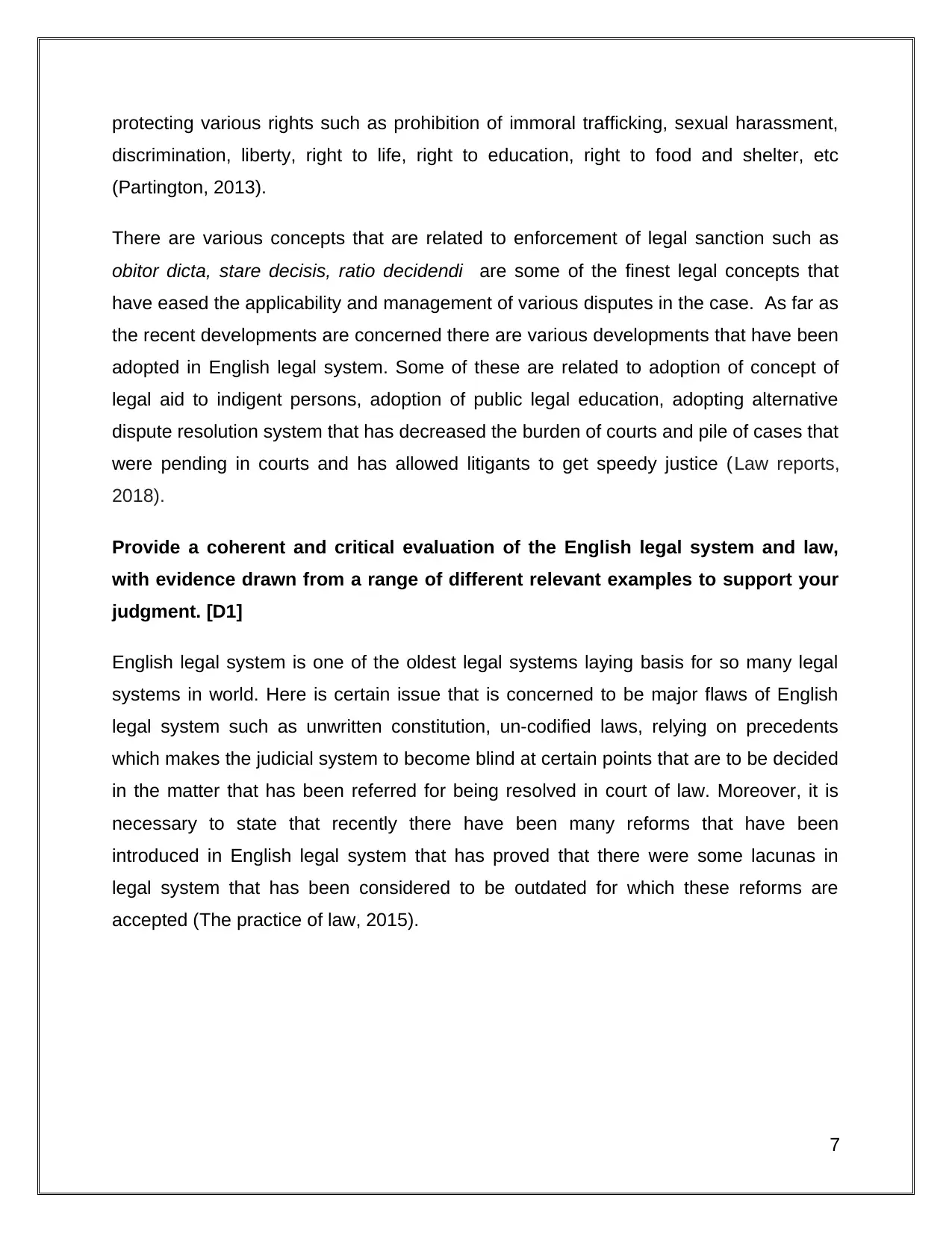
protecting various rights such as prohibition of immoral trafficking, sexual harassment,
discrimination, liberty, right to life, right to education, right to food and shelter, etc
(Partington, 2013).
There are various concepts that are related to enforcement of legal sanction such as
obitor dicta, stare decisis, ratio decidendi are some of the finest legal concepts that
have eased the applicability and management of various disputes in the case. As far as
the recent developments are concerned there are various developments that have been
adopted in English legal system. Some of these are related to adoption of concept of
legal aid to indigent persons, adoption of public legal education, adopting alternative
dispute resolution system that has decreased the burden of courts and pile of cases that
were pending in courts and has allowed litigants to get speedy justice (Law reports,
2018).
Provide a coherent and critical evaluation of the English legal system and law,
with evidence drawn from a range of different relevant examples to support your
judgment. [D1]
English legal system is one of the oldest legal systems laying basis for so many legal
systems in world. Here is certain issue that is concerned to be major flaws of English
legal system such as unwritten constitution, un-codified laws, relying on precedents
which makes the judicial system to become blind at certain points that are to be decided
in the matter that has been referred for being resolved in court of law. Moreover, it is
necessary to state that recently there have been many reforms that have been
introduced in English legal system that has proved that there were some lacunas in
legal system that has been considered to be outdated for which these reforms are
accepted (The practice of law, 2015).
7
discrimination, liberty, right to life, right to education, right to food and shelter, etc
(Partington, 2013).
There are various concepts that are related to enforcement of legal sanction such as
obitor dicta, stare decisis, ratio decidendi are some of the finest legal concepts that
have eased the applicability and management of various disputes in the case. As far as
the recent developments are concerned there are various developments that have been
adopted in English legal system. Some of these are related to adoption of concept of
legal aid to indigent persons, adoption of public legal education, adopting alternative
dispute resolution system that has decreased the burden of courts and pile of cases that
were pending in courts and has allowed litigants to get speedy justice (Law reports,
2018).
Provide a coherent and critical evaluation of the English legal system and law,
with evidence drawn from a range of different relevant examples to support your
judgment. [D1]
English legal system is one of the oldest legal systems laying basis for so many legal
systems in world. Here is certain issue that is concerned to be major flaws of English
legal system such as unwritten constitution, un-codified laws, relying on precedents
which makes the judicial system to become blind at certain points that are to be decided
in the matter that has been referred for being resolved in court of law. Moreover, it is
necessary to state that recently there have been many reforms that have been
introduced in English legal system that has proved that there were some lacunas in
legal system that has been considered to be outdated for which these reforms are
accepted (The practice of law, 2015).
7
Paraphrase This Document
Need a fresh take? Get an instant paraphrase of this document with our AI Paraphraser
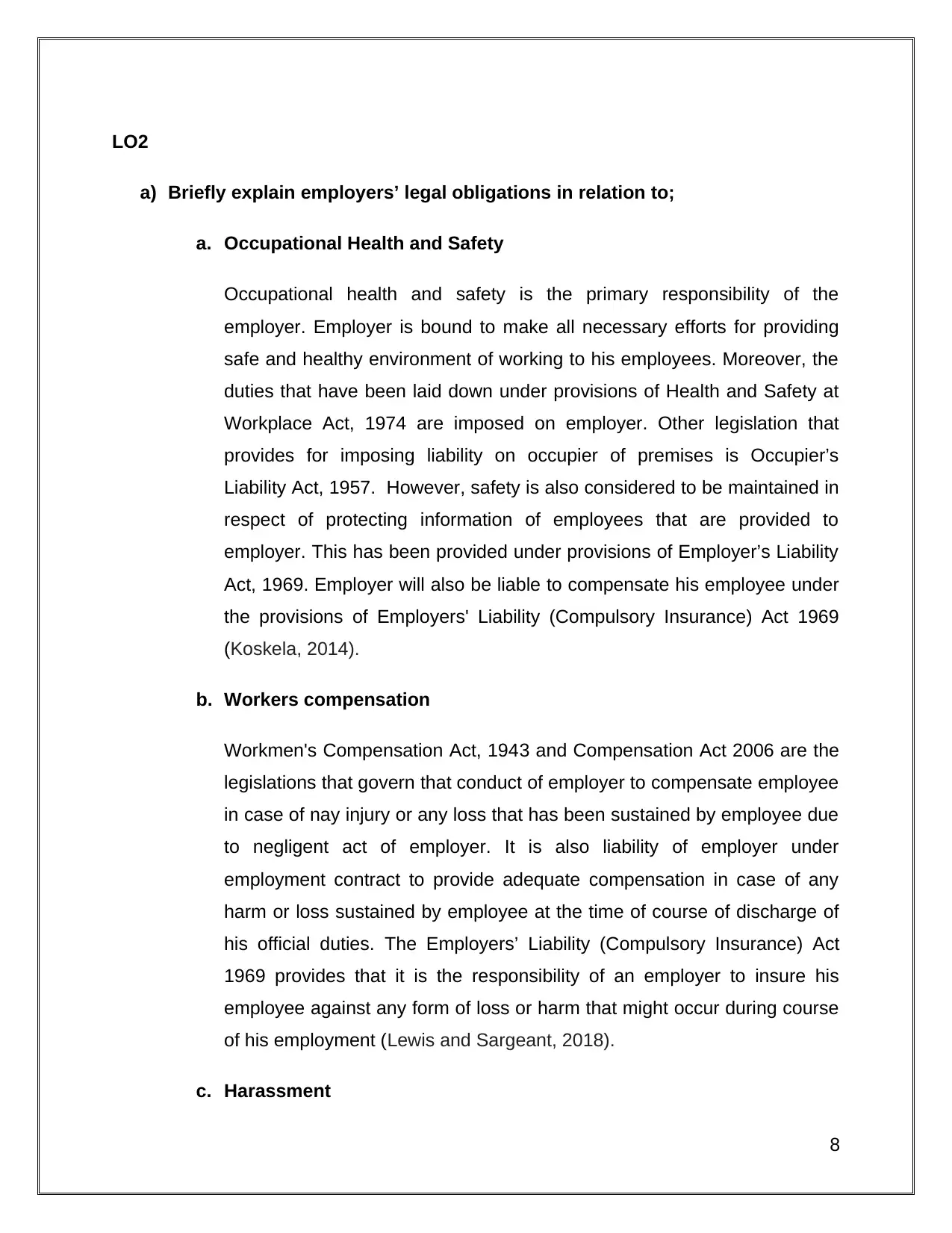
LO2
a) Briefly explain employers’ legal obligations in relation to;
a. Occupational Health and Safety
Occupational health and safety is the primary responsibility of the
employer. Employer is bound to make all necessary efforts for providing
safe and healthy environment of working to his employees. Moreover, the
duties that have been laid down under provisions of Health and Safety at
Workplace Act, 1974 are imposed on employer. Other legislation that
provides for imposing liability on occupier of premises is Occupier’s
Liability Act, 1957. However, safety is also considered to be maintained in
respect of protecting information of employees that are provided to
employer. This has been provided under provisions of Employer’s Liability
Act, 1969. Employer will also be liable to compensate his employee under
the provisions of Employers' Liability (Compulsory Insurance) Act 1969
(Koskela, 2014).
b. Workers compensation
Workmen's Compensation Act, 1943 and Compensation Act 2006 are the
legislations that govern that conduct of employer to compensate employee
in case of nay injury or any loss that has been sustained by employee due
to negligent act of employer. It is also liability of employer under
employment contract to provide adequate compensation in case of any
harm or loss sustained by employee at the time of course of discharge of
his official duties. The Employers’ Liability (Compulsory Insurance) Act
1969 provides that it is the responsibility of an employer to insure his
employee against any form of loss or harm that might occur during course
of his employment (Lewis and Sargeant, 2018).
c. Harassment
8
a) Briefly explain employers’ legal obligations in relation to;
a. Occupational Health and Safety
Occupational health and safety is the primary responsibility of the
employer. Employer is bound to make all necessary efforts for providing
safe and healthy environment of working to his employees. Moreover, the
duties that have been laid down under provisions of Health and Safety at
Workplace Act, 1974 are imposed on employer. Other legislation that
provides for imposing liability on occupier of premises is Occupier’s
Liability Act, 1957. However, safety is also considered to be maintained in
respect of protecting information of employees that are provided to
employer. This has been provided under provisions of Employer’s Liability
Act, 1969. Employer will also be liable to compensate his employee under
the provisions of Employers' Liability (Compulsory Insurance) Act 1969
(Koskela, 2014).
b. Workers compensation
Workmen's Compensation Act, 1943 and Compensation Act 2006 are the
legislations that govern that conduct of employer to compensate employee
in case of nay injury or any loss that has been sustained by employee due
to negligent act of employer. It is also liability of employer under
employment contract to provide adequate compensation in case of any
harm or loss sustained by employee at the time of course of discharge of
his official duties. The Employers’ Liability (Compulsory Insurance) Act
1969 provides that it is the responsibility of an employer to insure his
employee against any form of loss or harm that might occur during course
of his employment (Lewis and Sargeant, 2018).
c. Harassment
8
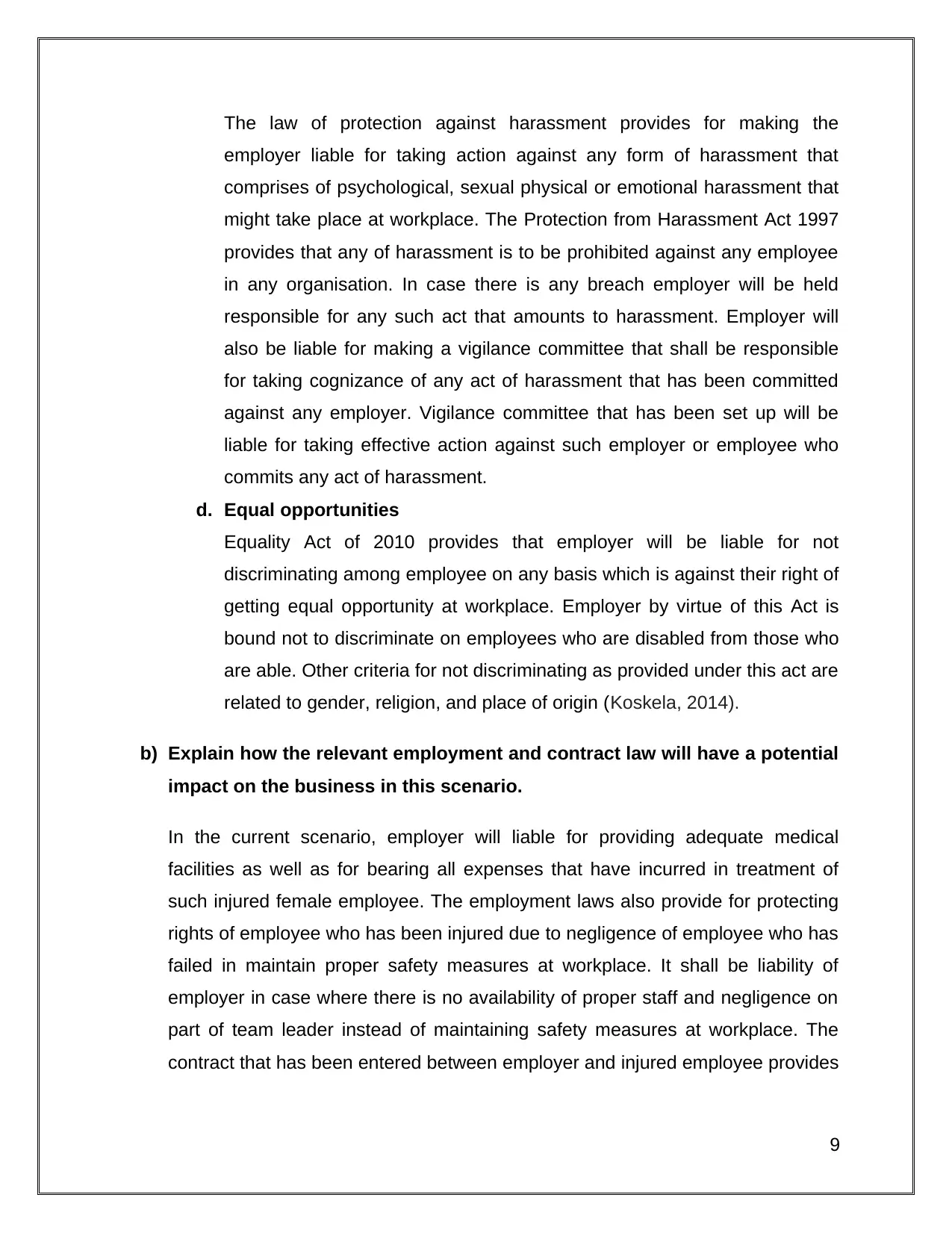
The law of protection against harassment provides for making the
employer liable for taking action against any form of harassment that
comprises of psychological, sexual physical or emotional harassment that
might take place at workplace. The Protection from Harassment Act 1997
provides that any of harassment is to be prohibited against any employee
in any organisation. In case there is any breach employer will be held
responsible for any such act that amounts to harassment. Employer will
also be liable for making a vigilance committee that shall be responsible
for taking cognizance of any act of harassment that has been committed
against any employer. Vigilance committee that has been set up will be
liable for taking effective action against such employer or employee who
commits any act of harassment.
d. Equal opportunities
Equality Act of 2010 provides that employer will be liable for not
discriminating among employee on any basis which is against their right of
getting equal opportunity at workplace. Employer by virtue of this Act is
bound not to discriminate on employees who are disabled from those who
are able. Other criteria for not discriminating as provided under this act are
related to gender, religion, and place of origin (Koskela, 2014).
b) Explain how the relevant employment and contract law will have a potential
impact on the business in this scenario.
In the current scenario, employer will liable for providing adequate medical
facilities as well as for bearing all expenses that have incurred in treatment of
such injured female employee. The employment laws also provide for protecting
rights of employee who has been injured due to negligence of employee who has
failed in maintain proper safety measures at workplace. It shall be liability of
employer in case where there is no availability of proper staff and negligence on
part of team leader instead of maintaining safety measures at workplace. The
contract that has been entered between employer and injured employee provides
9
employer liable for taking action against any form of harassment that
comprises of psychological, sexual physical or emotional harassment that
might take place at workplace. The Protection from Harassment Act 1997
provides that any of harassment is to be prohibited against any employee
in any organisation. In case there is any breach employer will be held
responsible for any such act that amounts to harassment. Employer will
also be liable for making a vigilance committee that shall be responsible
for taking cognizance of any act of harassment that has been committed
against any employer. Vigilance committee that has been set up will be
liable for taking effective action against such employer or employee who
commits any act of harassment.
d. Equal opportunities
Equality Act of 2010 provides that employer will be liable for not
discriminating among employee on any basis which is against their right of
getting equal opportunity at workplace. Employer by virtue of this Act is
bound not to discriminate on employees who are disabled from those who
are able. Other criteria for not discriminating as provided under this act are
related to gender, religion, and place of origin (Koskela, 2014).
b) Explain how the relevant employment and contract law will have a potential
impact on the business in this scenario.
In the current scenario, employer will liable for providing adequate medical
facilities as well as for bearing all expenses that have incurred in treatment of
such injured female employee. The employment laws also provide for protecting
rights of employee who has been injured due to negligence of employee who has
failed in maintain proper safety measures at workplace. It shall be liability of
employer in case where there is no availability of proper staff and negligence on
part of team leader instead of maintaining safety measures at workplace. The
contract that has been entered between employer and injured employee provides
9
⊘ This is a preview!⊘
Do you want full access?
Subscribe today to unlock all pages.

Trusted by 1+ million students worldwide
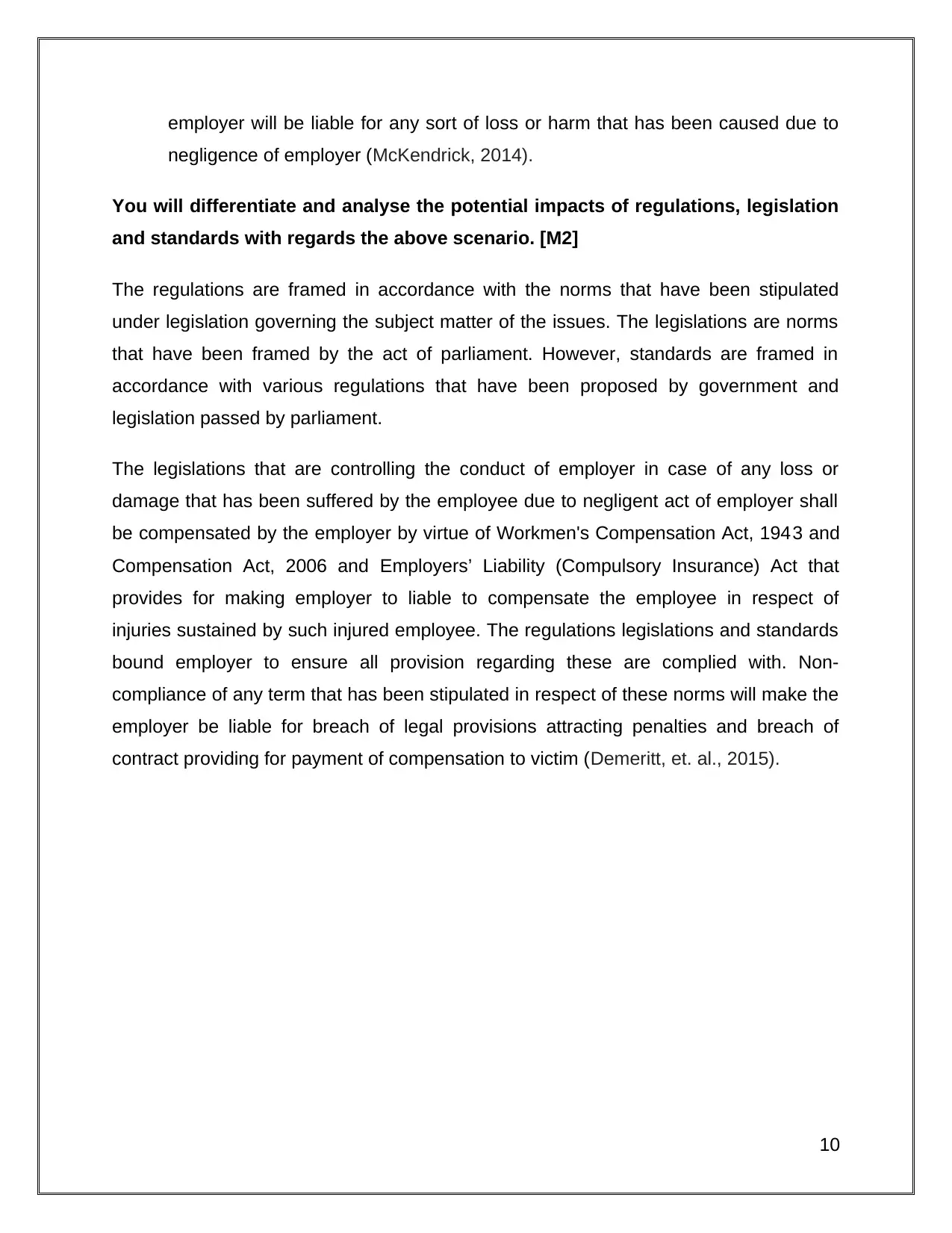
employer will be liable for any sort of loss or harm that has been caused due to
negligence of employer (McKendrick, 2014).
You will differentiate and analyse the potential impacts of regulations, legislation
and standards with regards the above scenario. [M2]
The regulations are framed in accordance with the norms that have been stipulated
under legislation governing the subject matter of the issues. The legislations are norms
that have been framed by the act of parliament. However, standards are framed in
accordance with various regulations that have been proposed by government and
legislation passed by parliament.
The legislations that are controlling the conduct of employer in case of any loss or
damage that has been suffered by the employee due to negligent act of employer shall
be compensated by the employer by virtue of Workmen's Compensation Act, 1943 and
Compensation Act, 2006 and Employers’ Liability (Compulsory Insurance) Act that
provides for making employer to liable to compensate the employee in respect of
injuries sustained by such injured employee. The regulations legislations and standards
bound employer to ensure all provision regarding these are complied with. Non-
compliance of any term that has been stipulated in respect of these norms will make the
employer be liable for breach of legal provisions attracting penalties and breach of
contract providing for payment of compensation to victim (Demeritt, et. al., 2015).
10
negligence of employer (McKendrick, 2014).
You will differentiate and analyse the potential impacts of regulations, legislation
and standards with regards the above scenario. [M2]
The regulations are framed in accordance with the norms that have been stipulated
under legislation governing the subject matter of the issues. The legislations are norms
that have been framed by the act of parliament. However, standards are framed in
accordance with various regulations that have been proposed by government and
legislation passed by parliament.
The legislations that are controlling the conduct of employer in case of any loss or
damage that has been suffered by the employee due to negligent act of employer shall
be compensated by the employer by virtue of Workmen's Compensation Act, 1943 and
Compensation Act, 2006 and Employers’ Liability (Compulsory Insurance) Act that
provides for making employer to liable to compensate the employee in respect of
injuries sustained by such injured employee. The regulations legislations and standards
bound employer to ensure all provision regarding these are complied with. Non-
compliance of any term that has been stipulated in respect of these norms will make the
employer be liable for breach of legal provisions attracting penalties and breach of
contract providing for payment of compensation to victim (Demeritt, et. al., 2015).
10
Paraphrase This Document
Need a fresh take? Get an instant paraphrase of this document with our AI Paraphraser
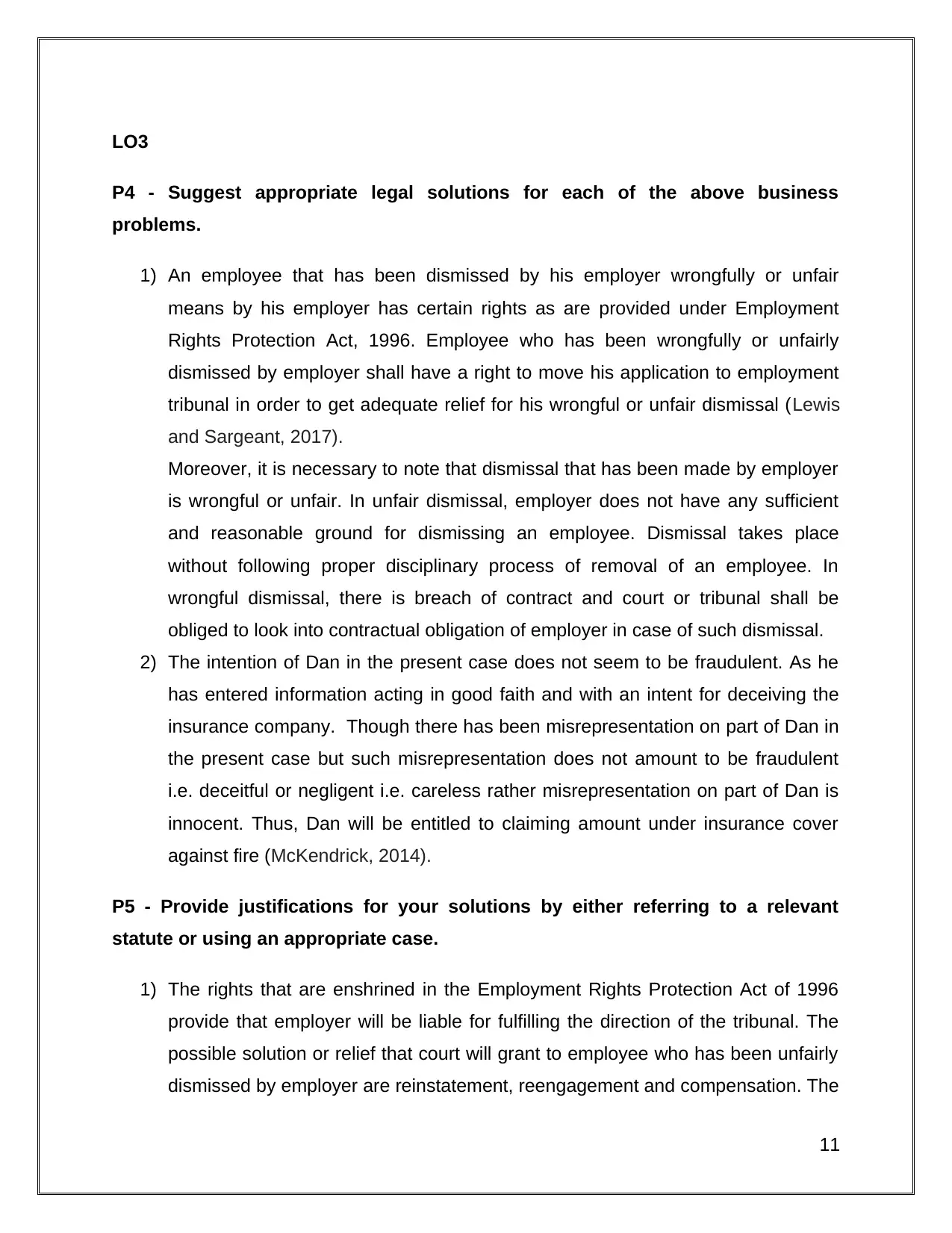
LO3
P4 - Suggest appropriate legal solutions for each of the above business
problems.
1) An employee that has been dismissed by his employer wrongfully or unfair
means by his employer has certain rights as are provided under Employment
Rights Protection Act, 1996. Employee who has been wrongfully or unfairly
dismissed by employer shall have a right to move his application to employment
tribunal in order to get adequate relief for his wrongful or unfair dismissal (Lewis
and Sargeant, 2017).
Moreover, it is necessary to note that dismissal that has been made by employer
is wrongful or unfair. In unfair dismissal, employer does not have any sufficient
and reasonable ground for dismissing an employee. Dismissal takes place
without following proper disciplinary process of removal of an employee. In
wrongful dismissal, there is breach of contract and court or tribunal shall be
obliged to look into contractual obligation of employer in case of such dismissal.
2) The intention of Dan in the present case does not seem to be fraudulent. As he
has entered information acting in good faith and with an intent for deceiving the
insurance company. Though there has been misrepresentation on part of Dan in
the present case but such misrepresentation does not amount to be fraudulent
i.e. deceitful or negligent i.e. careless rather misrepresentation on part of Dan is
innocent. Thus, Dan will be entitled to claiming amount under insurance cover
against fire (McKendrick, 2014).
P5 - Provide justifications for your solutions by either referring to a relevant
statute or using an appropriate case.
1) The rights that are enshrined in the Employment Rights Protection Act of 1996
provide that employer will be liable for fulfilling the direction of the tribunal. The
possible solution or relief that court will grant to employee who has been unfairly
dismissed by employer are reinstatement, reengagement and compensation. The
11
P4 - Suggest appropriate legal solutions for each of the above business
problems.
1) An employee that has been dismissed by his employer wrongfully or unfair
means by his employer has certain rights as are provided under Employment
Rights Protection Act, 1996. Employee who has been wrongfully or unfairly
dismissed by employer shall have a right to move his application to employment
tribunal in order to get adequate relief for his wrongful or unfair dismissal (Lewis
and Sargeant, 2017).
Moreover, it is necessary to note that dismissal that has been made by employer
is wrongful or unfair. In unfair dismissal, employer does not have any sufficient
and reasonable ground for dismissing an employee. Dismissal takes place
without following proper disciplinary process of removal of an employee. In
wrongful dismissal, there is breach of contract and court or tribunal shall be
obliged to look into contractual obligation of employer in case of such dismissal.
2) The intention of Dan in the present case does not seem to be fraudulent. As he
has entered information acting in good faith and with an intent for deceiving the
insurance company. Though there has been misrepresentation on part of Dan in
the present case but such misrepresentation does not amount to be fraudulent
i.e. deceitful or negligent i.e. careless rather misrepresentation on part of Dan is
innocent. Thus, Dan will be entitled to claiming amount under insurance cover
against fire (McKendrick, 2014).
P5 - Provide justifications for your solutions by either referring to a relevant
statute or using an appropriate case.
1) The rights that are enshrined in the Employment Rights Protection Act of 1996
provide that employer will be liable for fulfilling the direction of the tribunal. The
possible solution or relief that court will grant to employee who has been unfairly
dismissed by employer are reinstatement, reengagement and compensation. The
11
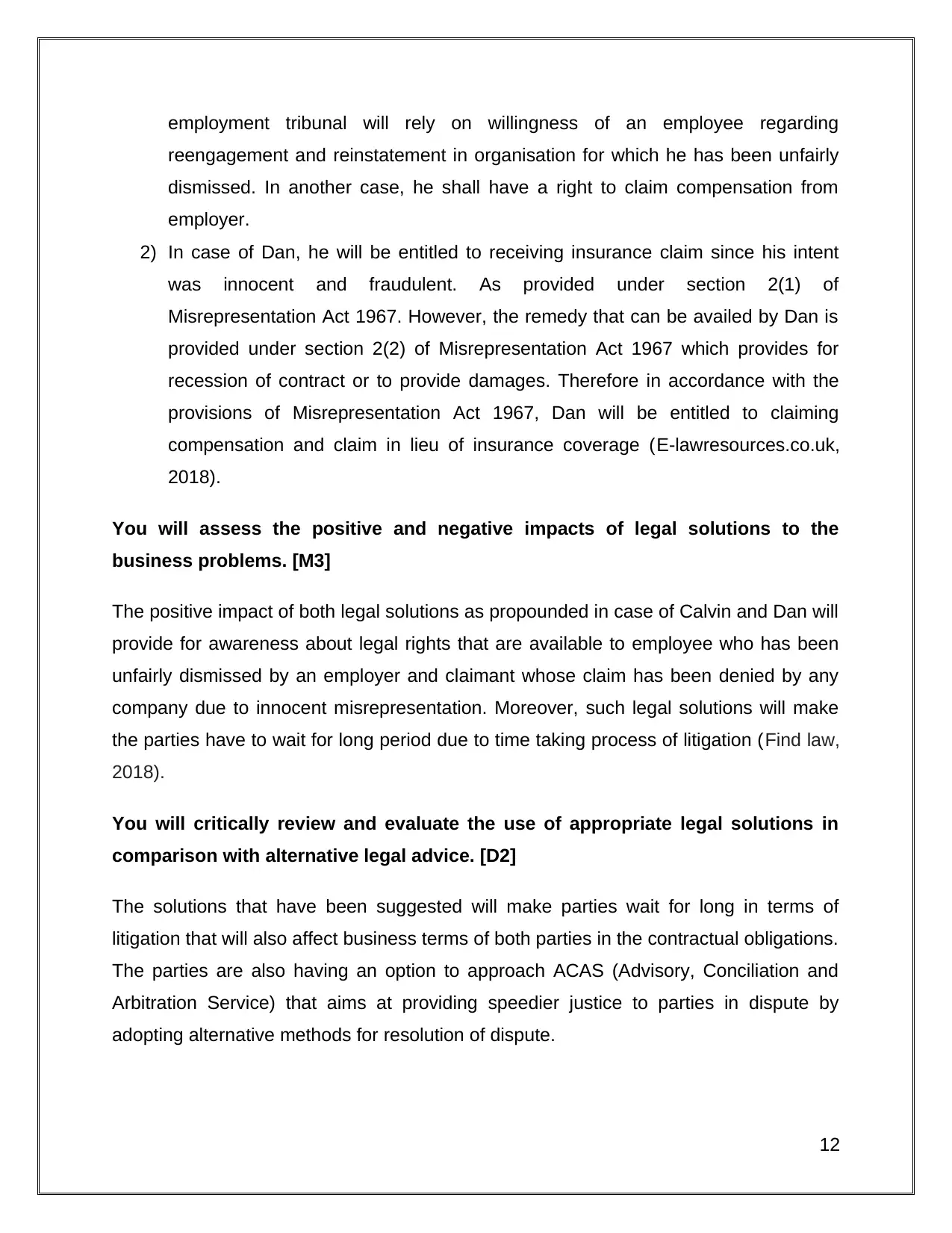
employment tribunal will rely on willingness of an employee regarding
reengagement and reinstatement in organisation for which he has been unfairly
dismissed. In another case, he shall have a right to claim compensation from
employer.
2) In case of Dan, he will be entitled to receiving insurance claim since his intent
was innocent and fraudulent. As provided under section 2(1) of
Misrepresentation Act 1967. However, the remedy that can be availed by Dan is
provided under section 2(2) of Misrepresentation Act 1967 which provides for
recession of contract or to provide damages. Therefore in accordance with the
provisions of Misrepresentation Act 1967, Dan will be entitled to claiming
compensation and claim in lieu of insurance coverage (E-lawresources.co.uk,
2018).
You will assess the positive and negative impacts of legal solutions to the
business problems. [M3]
The positive impact of both legal solutions as propounded in case of Calvin and Dan will
provide for awareness about legal rights that are available to employee who has been
unfairly dismissed by an employer and claimant whose claim has been denied by any
company due to innocent misrepresentation. Moreover, such legal solutions will make
the parties have to wait for long period due to time taking process of litigation (Find law,
2018).
You will critically review and evaluate the use of appropriate legal solutions in
comparison with alternative legal advice. [D2]
The solutions that have been suggested will make parties wait for long in terms of
litigation that will also affect business terms of both parties in the contractual obligations.
The parties are also having an option to approach ACAS (Advisory, Conciliation and
Arbitration Service) that aims at providing speedier justice to parties in dispute by
adopting alternative methods for resolution of dispute.
12
reengagement and reinstatement in organisation for which he has been unfairly
dismissed. In another case, he shall have a right to claim compensation from
employer.
2) In case of Dan, he will be entitled to receiving insurance claim since his intent
was innocent and fraudulent. As provided under section 2(1) of
Misrepresentation Act 1967. However, the remedy that can be availed by Dan is
provided under section 2(2) of Misrepresentation Act 1967 which provides for
recession of contract or to provide damages. Therefore in accordance with the
provisions of Misrepresentation Act 1967, Dan will be entitled to claiming
compensation and claim in lieu of insurance coverage (E-lawresources.co.uk,
2018).
You will assess the positive and negative impacts of legal solutions to the
business problems. [M3]
The positive impact of both legal solutions as propounded in case of Calvin and Dan will
provide for awareness about legal rights that are available to employee who has been
unfairly dismissed by an employer and claimant whose claim has been denied by any
company due to innocent misrepresentation. Moreover, such legal solutions will make
the parties have to wait for long period due to time taking process of litigation (Find law,
2018).
You will critically review and evaluate the use of appropriate legal solutions in
comparison with alternative legal advice. [D2]
The solutions that have been suggested will make parties wait for long in terms of
litigation that will also affect business terms of both parties in the contractual obligations.
The parties are also having an option to approach ACAS (Advisory, Conciliation and
Arbitration Service) that aims at providing speedier justice to parties in dispute by
adopting alternative methods for resolution of dispute.
12
⊘ This is a preview!⊘
Do you want full access?
Subscribe today to unlock all pages.

Trusted by 1+ million students worldwide
1 out of 17
Related Documents
Your All-in-One AI-Powered Toolkit for Academic Success.
+13062052269
info@desklib.com
Available 24*7 on WhatsApp / Email
![[object Object]](/_next/static/media/star-bottom.7253800d.svg)
Unlock your academic potential
Copyright © 2020–2025 A2Z Services. All Rights Reserved. Developed and managed by ZUCOL.




